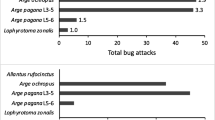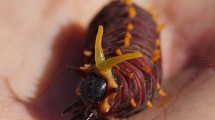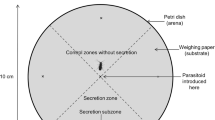Abstract
All larvae in the family Papilionidae possess osmeteria, eversible glands that release defensive chemicals upon disturbance. These chemicals have been shown to be repellent to ants, mantids, and other predaceous arthropods with chewing mouthparts. In this study, we demonstrate that the pentatomid Podisus maculiventris,an important predator of the black swallowtail Papilio polyxenes,is capable of piercing the body wall of the caterpillar and consuming body fluids without eliciting osmeterial eversion. Tenebrio molitorlarvae coated with osmeterial secretions of Papilio polyxeneswere universally rejected by Podisus maculiventris,suggesting that the predator is in fact repelled by the swallowtail defensive chemistry. By circumventing the defensive behavior of the caterpillar, the pentatomid is able to utilize an otherwise chemically unsuitable prey species.
Similar content being viewed by others
References
Blau, W. S. (1980). Notes on the natural history ofPapilio polyxenes stabilis (Papilionidae) in Costa Rica.J. Lep. Soc. 34:321–324.
Blum, M. S. (1981).Chemical Defenses of Arthropods, Academic Press, New York.
Chow, Y. S., and Tsai, R. S. (1989). Protective chemicals in caterpillar survival.Experientia 45: 390–392.
Damman, H. (1986). The osmaterial [sic] glands of the swallowtail butterflyEurytides marcellus as a defense against natural enemies.Ecol. Entomol. 11: 261–265.
Eisemann, C. H., Jorgensen, W. K., Merritt, D. J., Rice, M. F., Cribb, B. W., Webb, P. D., and Zaluck, M. P. (1984). Do insects feel pain? A biological view.Experientia 40: 164–167.
Eisner, T., and Meinwald, Y. (1965). Defensive secretion of a caterpillar (Papilio).Science 150: 1733–1735.
Feeny, P., Blau, W. S., and Kareiva, P. M. (1985). Larval growth and survivorship of the black swallowtail butterfly in central New York.Ecol. Monogr. 55: 167–187.
Honda, K. (1981). Larval osmeterial secretions of the swallowtails.J. Chem. Ecol. 7: 1089–1113.
Honda, K. (1983). Defensive potential of the larval osmeterial secretions of papilionid butterflies against ants.Physiol. Entomol. 8: 173–179.
Jaervi, T., Sillen-Tullberg, B., and Wiklund, C. (1981). The cost of being aposematic. An experimental study of predation on larvae ofPapilio machaon by the great titParus major.Oikos 36: 267–272.
Leslie, A. J., and Berenbaum, M. R. (1990). Role of the osmeterial gland in swallowtail larvae (Papilionidae) in defense against an avian predator.J. Lep. Soc. 44: 245–251.
O'Neil, R. J. (1988). Predation byPodisus maculiventris (Say) on Mexican bean beetle,Epilachna varivestis Mulsant, in Indiana soybeans.Can. Entomol. 120: 161–166.
Ribiero, J. M. (1982). The antiserotonin and antihistamine activities of salivary secretions ofRhodnius prolixus.J. Insect Physiol. 28: 655–660.
Tostowaryk, W. (1971). Life history and behaviorof Podisus maculiventris (Hemiptera: Pentatomidae) in boreal forest in Quebec.Can. Entomol. 103: 662–673.
Tostowaryk, W. (1972). The effect of prey defense on the functional response ofPodisus modestus (Hemiptera: Pentatomidae) to densities of the sawfliesNeodiprion swainei andN. pratt.-banksianae (Hymenoptera: Neodiprionidae).Can. Entomol. 104: 61–69.
Wiklund, C., and Sillen-Tullberg, B. (1985). Why distasteful butterflies have aposematic larvae and adults, but cryptic pupae: evidence from predation experiments on the monarch and the European swallowtail.Evolution 39: 1155–1158.
Author information
Authors and Affiliations
Rights and permissions
About this article
Cite this article
Berenbaum, M.R., Moreno, B. & Green, E. Soldier bug predation on swallowtail caterpillars (Lepidoptera: Papilionidae): Circumvention of defensive chemistry. J Insect Behav 5, 547–553 (1992). https://doi.org/10.1007/BF01048003
Accepted:
Issue Date:
DOI: https://doi.org/10.1007/BF01048003




